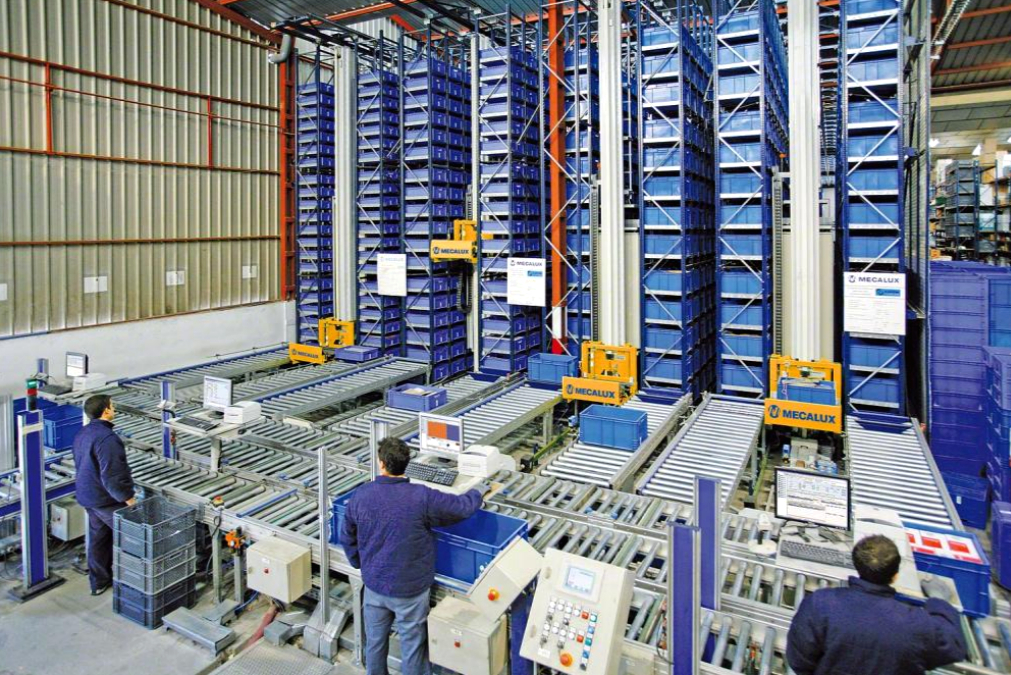Automated systems aim to ensure use of maximum available space, both horizontally and vertically, and simplify the work of a warehouse. Miniload solutions are designed for relatively small loads. Their effectiveness has been checked by one of the retail chains and by a supplier of parts for automotive industry.
Miniload technology is applied in many sectors and at the same time, it is successfully used in distribution centers. Many types of storage and transport packages can be processed automatically: cardboard boxes, plastic containers of different dimensions and trays of different sizes.
The latter is used for storing parts or structural elements, and subsequently delivering them to the production line as well as for storing goods and driving order retrieval, picking, and packing, e.g. in automotive, clothing and retail industries.
It is possible to automatically buffer prepared orders, release boxes or containers for dispatch and drive module solutions based on GTP technology (Goods-to-Person).
SSI Schaefer underlines that entire warehouse units, full of small parts, are computer-controlled and transported with the use of unmanned, automated storage and search systems. Then, they are transported to appropriate commissioning points by conveyors.
Miniload opens up opportunities for e-commerce
Solution providers have no doubts that technology is a driver of development, and in this particular case also technology will have an influence on a higher number of miniload systems implemented in the future.
Apart from problems in the labor market (difficulties to attract new and retain current employees), the growing interest in miniload technology is also driven by the development of enterprises. To take one example: for companies from e-commerce industry successful functioning based on traditional technologies is increasingly difficult, and in some cases even impossible.
Miniload modules with order picking channels are applied in:
– small parts warehouses with a big flow of materials;
– tool rooms;
– buffer warehouses for prepared containers/boxes awaiting dispatch.
Automated case-picking warehouse
There are numerous examples of such implementations. One of the most spectacular ones is Kiekert, a supplier in the automotive industry, for which Logzact carried out a project of an automated case-picking warehouse. The proposed arrangement consists of two Swisslog Tornado 12 m high stacker cranes, racks, and conveyors as well as the MFC+ system managing the automated case-picking warehouse with an interface for SAP system.
The racks compose a standard open face double and quadruple deep structure. It means that one rack is suitable for two containers with a base area of 600 x 400 mm or four containers with a base area of 300 x 400 mm. However, it does not mean that in the location only a given type of containers has to be stored – multiple combinations are possible, e.g. one carrier with a base area of 600 x 400 mm and two carriers with a base area of 300 x 400 mm.
The client’s requirements as to the efficiency have been estimated on the basis of data from the production, and the conclusion was 200 containers in and 200 containers out within an hour. The solution met the client’s expectations, providing also some reserve of efficiency and capacity for the future.
Increased storage capacity
Mecalux has prepared a solution tailored to the needs of Unidroco. This Spanish company owns a chain of 200 shops offering cosmetics and perfumes and over 30 shops specialized in selling paints and decorative accessories.
The newly designed and implemented project was based on a product-to-operator system, enabling at the same time supplementing the stock. The assembly of the design was divided into three stages. As a result, an automated case-picking warehouse was created, composed of 14 rows of racks supported by seven stacker cranes, conveyor system and manual order picking zone having four posts adapted to wave picking.

Besides, Easy WMS system was implemented in the warehouse, which allowed to control each product, deciding where it should be directed and adapting certain actions to the parameters of a product from the moment of entering to the moment of leaving the warehouse.
Benefits for Unidroco:
– bigger storage capacity: total storage capacity is 14.2 thousand containers with dimensions of 800 x 600 x 420 mm and load up to 100 kg;
– increased productivity (the solution applied enables increasing the number of inputs and outputs, which is directly translated into the increase in the number of orders completed);
– improved work safety: automated systems practically do not need human assistance, so the risk of accident at work is significantly reduced;
– effective management: with Easy WMS warehouse management system and Galileo control, Unidroco can manage all processes, actions, and operations conducted in the warehouse.
Photo: Mecalux









